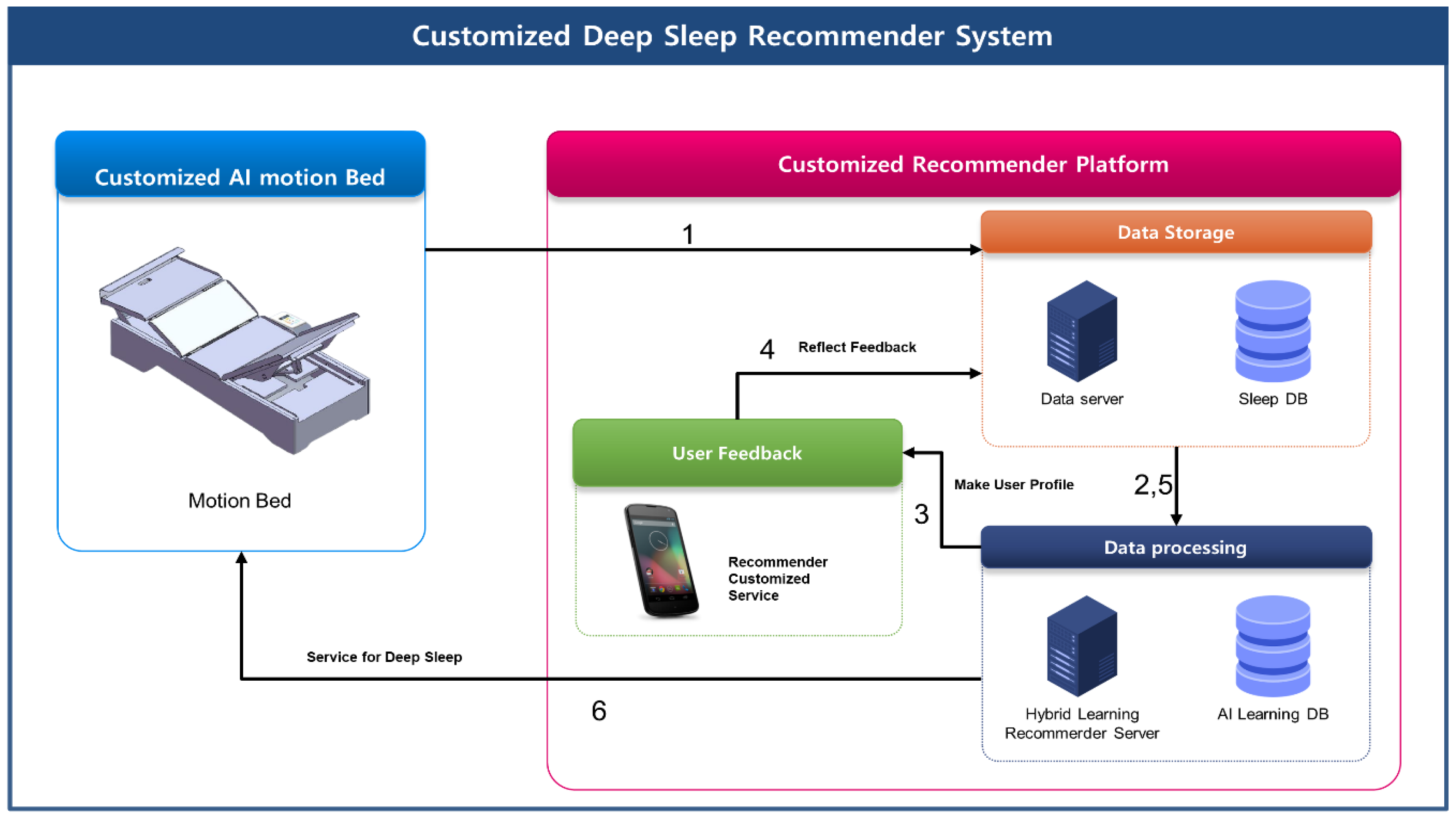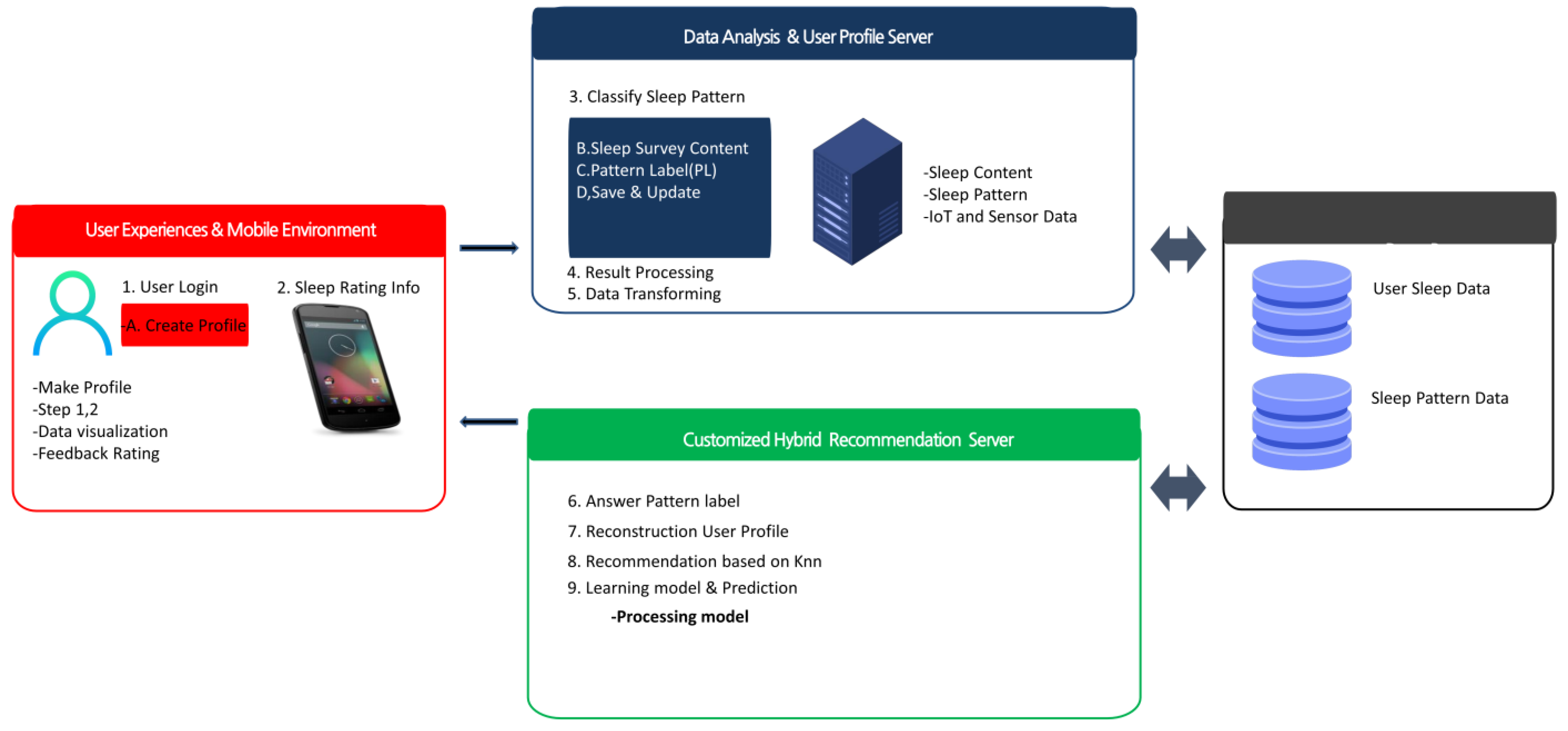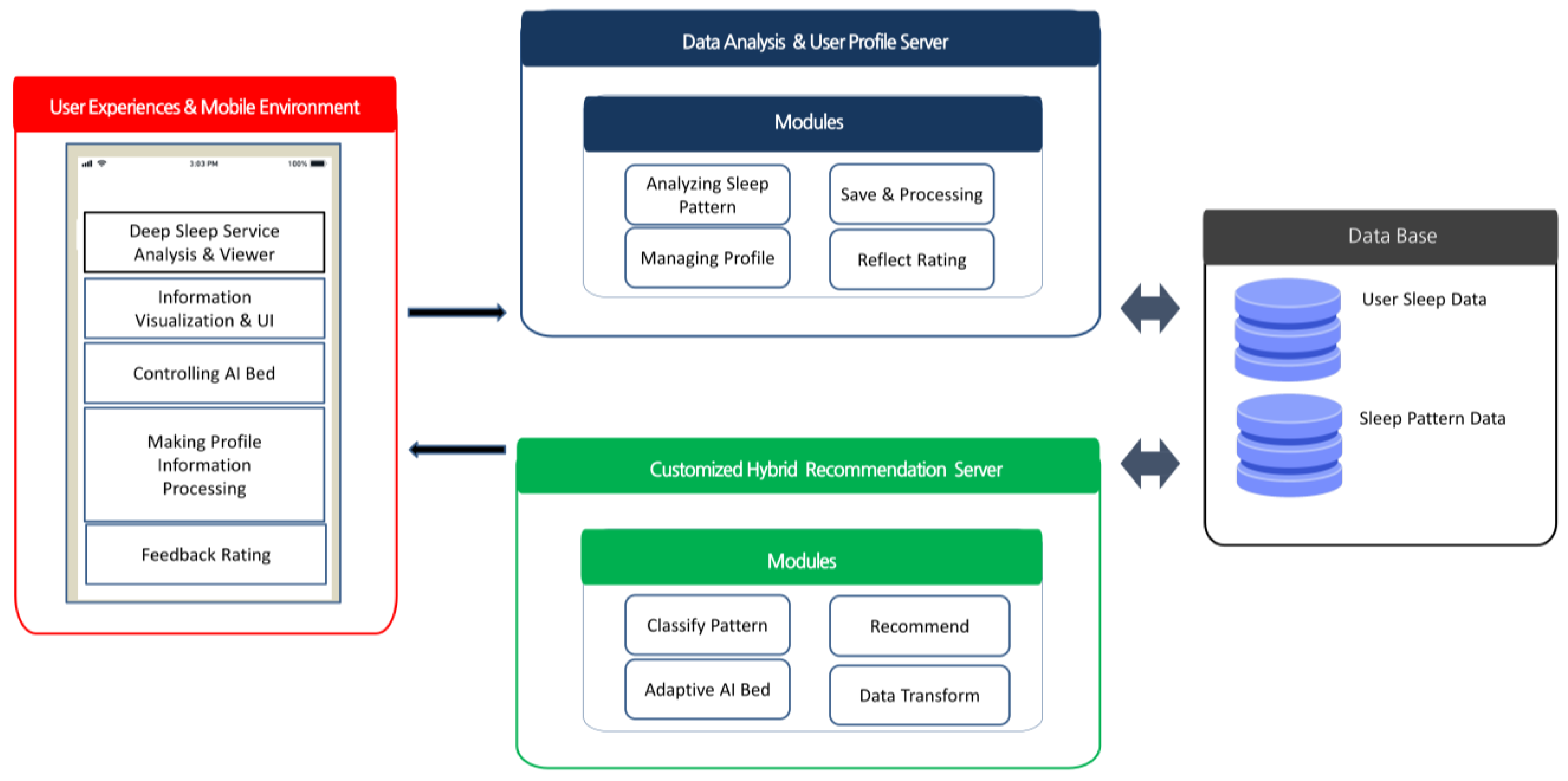Your browser does not fully support modern features. Please upgrade for a smoother experience.
Please note this is an old version of this entry, which may differ significantly from the current revision.
Sleep is one of the most important factors for human life in modern society. Optimal sleep contributes to increasing work efficiency and controlling overall well-being. Therefore, a sleep recommendation service is considered a necessary service for modern individuals.
- recommender system
- deep learning
- sleep technology
1. Introduction
Sleep is considered to be one of the most significant factors in modern society that affects human life [1]. As we can see from events like “World Sleep Day,” the importance of sleep is emphasized in our daily lives, and efforts are being made worldwide to prevent and manage sleep disorders. Sleep technology, or “sleep tech,” is recognized as a future industry and is gaining traction, as demonstrated by its inclusion in CES 2020~2022, and it is evolving into various fields through the integration of artificial intelligence and IoT technologies [2][3][4].
Sleep technology, also known as “sleep tech”, is a combination of sleep and technology that aims to improve the quality of sleep by analyzing sleep-related data. The initial steps in this field involved the integration and development of IoT technology [5]. One of the representative products is the motion bed, which collects sleep data from the user and analyzes them to improve the user’s sleep environment [6][7]. Other research directions in sleep technology involve data analysis such as brainwave analysis. Standardized evaluation guidelines are being designed using biological data collected from existing IoT devices, and service satisfaction is being improved through user satisfaction surveys [8]. However, because sleep evaluation guidelines vary between studies and there is no international standard for optimal sleep, it cannot be deemed sufficient to provide accurate sleep state predictions and personalized services. In order to provide personalized sleep services, a requirement for personalized sleep pattern analysis is present [9].
2. Deep Sleep Recommender System
2.1. Recommender Systems
Recommender systems (RSs) provide necessary and accurate information to help users choose the most suitable option in a particular environment. This has made RSs popular software [10]. They are successfully used by platform-oriented companies such as Netflix and YouTube to provide recommendations to users [11][12]. The goal of an RS is to provide personalized content to users, which can reduce their selection time and increase efficiency. Additionally, when used by many users, RSs can help identify situational needs. There are various types of recommendation algorithms, such as collaborative filtering, content-based filtering, and user-based filtering. However, these types of filtering have a major drawback [13]. When a new user starts using the system, the cold start problem occurs. Many studies have been conducted to address the cold start problem [14][15].
The fields that most use recommendation systems include clothing, movies, and food, among others, and recommendations are provided based on the user’s psychology, personality, and situational information. To provide recommendations, it is important to understand the correlations between this information or apply it according to the RS algorithm. RSs can also provide personalized medicine and digital healthcare in the sleep tech field, helping users improve their health, and can increase the level of predicting and evaluating content by utilizing sleep data [16][17].
2.2. Deep Learning (DL)
Deep learning is one of the methods for implementing artificial intelligence, analyzing data, and deriving results based on algorithms. This is why deep learning is popular in building personalized systems [18][19][20]. Deep learning is used in various fields, and machine learning is divided into three types of learning methods: supervised learning, unsupervised learning, and reinforcement learning [21]. Among them, deep learning is a machine learning method that uses neural networks. Current research shows that machine learning techniques and filtering techniques are used in recommendation systems. Hybrid methods that can use deep learning to improve recommendations are also available [22][23].
2.3. Sleep Technology
Sleep is an essential element of human life, but it can be overlooked in modern times, leading to sleep disorders. For this reason, sleep tech is gaining popularity, and a significant amount of research is being conducted [24][25][26]. Recent techniques in sleep include sleep posture recognition using microwave Doppler radar and machine learning classifiers and sleep posture recognition using dual-frequency microwave Doppler radar [27][28][29][30][31][32]. However, since there is no standard for sleep data, it is difficult for recommendation systems to provide accurate content. As sleep patterns define machine learning and recommendation system performance, further research is needed. In this paper, the main goal is to create a standard using pattern analysis based on cluster characteristics to improve system efficiency using machine learning.
2.4. Personalized Systems
The fourth industrial revolution has led to innovative technological advancements such as cloud computing and artificial intelligence, but it has also given rise to the important element of personalized systems [33]. One of the most prominent examples is personalized recommendation systems. These systems provide tailored recommendation services based on a user’s information. When users are satisfied, the quality of the service improves, leading to expansion into various fields.
3. The Proposed CDSRS (Customized Deep Sleep Recommender System)
The Customized Deep Sleep Recommender System (CDSRS) process is carried out according to steps 1 to 6 shown in Figure 1. In step 1, it collects sleep information using a customized AI motion bed and transmits the data necessary to create a personal profile. In step 2, the data server in the data store is used to configure the user’s profile and sleep content, and step 3 reconstructs the user’s profile when evaluation information is sent. The hybrid learning method in data processing learns algorithms based on user profiles and user evaluations. In step 4, user feedback provides user profiles and collects user evaluation information, which is then transmitted to the data server. The feedback function helps improve the accuracy of sleep recommendations for users. In step 6, it provides sleep services using motion beds to users through recommendations.

Figure 1. Customized Deep Sleep Recommender System (CDSRS).
The sleep system is composed of user sleep data and recommendation information, which are important parts of sleep care. Figure 2 and Figure 3 illustrate the concept of technological development for sleep care design models, system overview, structure, and service utilization cases in the service flow. Figure 2 shows the concept of the service model and introduces the components of each service.

Figure 2. CDSRS service model and service flow steps.

Figure 3. System architecture of the CDSRS.
The model consists of nine steps in sequential order. Clustering is performed in steps 3 to 5 using the user’s sleep data to define patterns. Currently, the user’s sleep data are rearranged into patterns. Steps 6 to 9 express detailed sleep patterns by adding user satisfaction data through additional surveys. The user’s satisfaction data, obtained through the survey, are used to respecify the recommendation presented to the user. The CDSRS uses a hybrid learning method to learn and test the dataset, evaluate the learning model, and provide more appropriate recommendations based on the user’s sleep evaluation through top-N recommendations with higher accuracy than traditional filtering techniques. Fusion care is defined by combining user feedback evaluations with sleep data. The preferred sleep pattern is constructed by determining the healthcare service paradigm and data content. Additionally, a personalized profile is created through the service model, which suggests individualized services by analyzing noise and BMI during sleep.
This entry is adapted from the peer-reviewed paper 10.3390/s23156670
References
- Grandner, M.A. Sleep, health, and society. Sleep Med. Clin. 2017, 12, 1–22.
- Perez-Pozuelo, I.; Zhai, B.; Palotti, J.; Mall, R.; Aupetit, M.; Garcia-Gomez, J.M.; Taheri, S.; Guan, Y.; Fernandez-Luque, L. The future of sleep health: A data-driven revolution in sleep science and medicine. NPJ Digit. Med. 2020, 3, 42.
- Gradisar, M.; Gardner, G.; Dohnt, H. Recent worldwide sleep patterns and problems during adolescence: A review and meta-analysis of age, region, and sleep. Sleep Med. 2011, 12, 110–118.
- Han, H.; Jo, J.; Son, Y.; Park, J. Smart sleep care system for quality sleep. In Proceedings of the 2015 International Conference on Information and Communication Technology Convergence (ICTC), Jeju, Republic of Korea, 28–30 October 2015; pp. 393–398.
- Schaltenbrand, N.; Lengelle, R.; Macher, J.-P. Neural network model: Application to automatic analysis of human sleep. Comput. Biomed. Res. 1993, 26, 157–171.
- Kogure, T.; Shirakawa, S.; Shimokawa, M.; Hosokawa, Y. Automatic sleep/wake scoring from body motion in bed: Validation of a newly developed sensor placed under a mattress. J. Physiol. Anthropol. 2011, 30, 103–109.
- Laurino, M.; Arcarisi, L.; Carbonaro, N.; Gemignani, A.; Menicucci, D.; Tognetti, A. A smart bed for non-obtrusive sleep analysis in real world context. IEEE Access 2020, 8, 45664–45673.
- Baron, K.G.; Duffecy, J.; Berendsen, M.A.; Mason, I.C.; Lattie, E.G.; Manalo, N.C. Feeling validated yet? A scoping review of the use of consumer-targeted wearable and mobile technology to measure and improve sleep. Sleep Med. Rev. 2018, 40, 151–159.
- Amatriain, X. Mining large streams of user data for personalized recommendations. ACM SIGKDD Explor. Newsl. 2013, 14, 37–48.
- Adomavicius, G.; Tuzhilin, A. Toward the next generation of recommender systems: A survey of the state-of-the-art and possible extensions. IEEE Trans. Knowl. Data Eng. 2005, 17, 734–749.
- Gomez-Uribe, C.A.; Hunt, N. The netflix recommender system: Algorithms, business value, and innovation. ACM Trans. Manag. Inf. Syst. 2015, 6, 1–19.
- Davidson, J.; Liebald, B.; Liu, J.; Nandy, P.; Van Vleet, T.; Gargi, U.; Gupta, S.; He, Y.; Lambert, M.; Livingston, B. The YouTube video recommendation system. In Proceedings of the Fourth ACM Conference on Recommender Systems, Barcelona, Spain, 26–30 September 2010; pp. 293–296.
- Lika, B.; Kolomvatsos, K.; Hadjiefthymiades, S. Facing the cold start problem in recommender systems. Expert Syst. Appl. 2014, 41, 2065–2073.
- Wei, J.; He, J.; Chen, K.; Zhou, Y.; Tang, Z. Collaborative filtering and deep learning based recommendation system for cold start items. Expert Syst. Appl. 2017, 69, 29–39.
- Bobadilla, J.; Ortega, F.; Hernando, A.; Bernal, J. A collaborative filtering approach to mitigate the new user cold start problem. Knowl.-Based Syst. 2012, 26, 225–238.
- Rayward, A.T.; Duncan, M.J.; Brown, W.J.; Plotnikoff, R.C.; Burton, N.W. A cross-sectional cluster analysis of the combined association of physical activity and sleep with sociodemographic and health characteristics in mid-aged and older adults. Maturitas 2017, 102, 56–61.
- Wiesner, M.; Pfeifer, D. Health recommender systems: Concepts, requirements, technical basics and challenges. Int. J. Environ. Res. Public Health 2014, 11, 2580–2607.
- Praveen, B.; Talukdar, S.; Mahato, S.; Mondal, J.; Sharma, P.; Islam, A.R.M.; Rahman, A. Analyzing trend and forecasting of rainfall changes in India using non-parametrical and machine learning approaches. Sci. Rep. 2020, 10, 10342.
- Jordan, M.I.; Mitchell, T.M. Machine learning: Trends, perspectives, and prospects. Science 2015, 349, 255–260.
- Raschka, S.; Patterson, J.; Nolet, C. Machine learning in python: Main developments and technology trends in data science, machine learning, and artificial intelligence. Information 2020, 11, 193.
- El Naqa, I.; Murphy, M.J. What Is Machine Learning? Springer: Berlin/Heidelberg, Germany, 2015.
- Shon, T.; Moon, J. A hybrid machine learning approach to network anomaly detection. Inf. Sci. 2007, 177, 3799–3821.
- Saravi, B.; Hassel, F.; Ülkümen, S.; Zink, A.; Shavlokhova, V.; Couillard-Despres, S.; Boeker, M.; Obid, P.; Lang, G.M. Artificial intelligence-driven prediction modeling and decision making in spine surgery using hybrid machine learning models. J. Pers. Med. 2022, 12, 509.
- Datko, P.; Scherz, W.D.; Velicu, O.R.; Seepold, R.; Madrid, N.M. Personal recommendation system for improving sleep quality. In Proceedings of the Intelligent Decision Technologies 2016: Proceedings of the 8th KES International Conference on Intelligent Decision Technologies (KES-IDT 2016)—Part I, Puerto de la Cruz, Spain, 15–17 June 2016; pp. 405–412.
- Liao, W.-H.; Yang, C.-M. Video-based activity and movement pattern analysis in overnight sleep studies. In Proceedings of the 2008 19th International Conference on Pattern Recognition, Tampa, FL, USA, 8–11 December 2008; pp. 1–4.
- Pandey, V.; Upadhyay, D.D.; Nag, N.; Jain, R.C. Personalized User Modelling for Context-Aware Lifestyle Recommendations to Improve Sleep. In Proceedings of the HealthRecSys@ RecSys, Online, 26 September 2020; pp. 8–14.
- Droitcour, A.; Lubecke, V.; Lin, J.; Boric-Lubecke, O. A microwave radio for Doppler radar sensing of vital signs. In Proceedings of the 2001 IEEE MTT-S International Microwave Sympsoium Digest (Cat. No. 01CH37157), Phoenix, AZ, USA, 20–24 May 2001; pp. 175–178.
- Singh, A.; Lubecke, V.; Boric-Lubecke, O. Pulse pressure monitoring through non-contact cardiac motion detection using 2.45 GHz microwave Doppler radar. In Proceedings of the 2011 Annual International Conference of the IEEE Engineering in Medicine and Biology Society, Boston, MA, USA, 30 August–3 September 2011; pp. 4336–4339.
- Zakrzewski, M.; Raittinen, H.; Vanhala, J. Comparison of center estimation algorithms for heart and respiration monitoring with microwave Doppler radar. IEEE Sens. J. 2011, 12, 627–634.
- Kagawa, M.; Ueki, K.; Tojima, H.; Matsui, T. Noncontact screening system with two microwave radars for the diagnosis of sleep apnea-hypopnea syndrome. In Proceedings of the 2013 35th Annual International Conference of the IEEE Engineering in Medicine and Biology Society (EMBC), Osaka, Japan, 3–7 July 2013; pp. 2052–2055.
- Lee, Y.S.; Pathirana, P.N.; Steinfort, C.L.; Caelli, T. Monitoring and analysis of respiratory patterns using microwave doppler radar. IEEE J. Transl. Eng. Health Med. 2014, 2, 1800912.
- Islam, S.M.M.; Lubecke, V.M. Sleep posture recognition with a dual-frequency microwave Doppler radar and machine learning classifiers. IEEE Sens. Lett. 2022, 6, 3500404.
- Schwab, K. The Fourth Industrial Revolution. 2017. Available online: https://www.weforum.org/about/the-fourth-industrial-revolution-by-klaus-schwab (accessed on 23 July 2023).
This entry is offline, you can click here to edit this entry!
